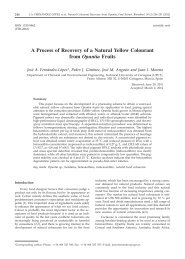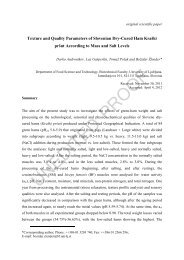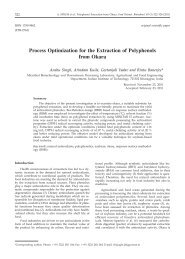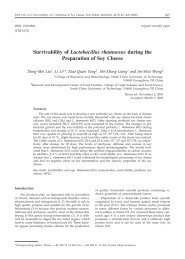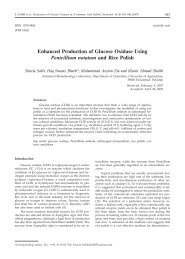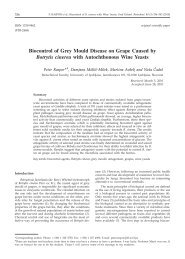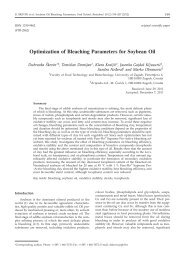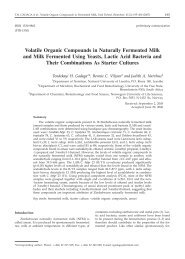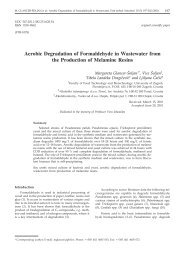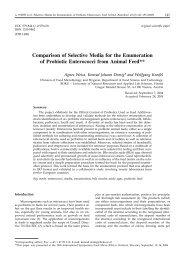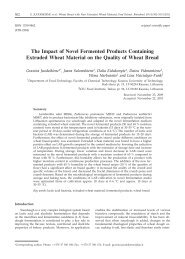Cloning, Functional Expression and Characterization of L ...
Cloning, Functional Expression and Characterization of L ...
Cloning, Functional Expression and Characterization of L ...
Create successful ePaper yourself
Turn your PDF publications into a flip-book with our unique Google optimized e-Paper software.
288 J. VIDYA et al.: L-Asparaginase II from E. coli MTCC 739, Food Technol. Biotechnol. 49 (3) 286–290 (2011)<br />
at 450 nm. Experimental values were calculated as an<br />
average <strong>of</strong> three independent measurements. The enzyme<br />
activity <strong>of</strong> recombinant protein was determined using an<br />
ammonium sulphate calibration curve. One unit <strong>of</strong> enzyme<br />
activity was defined as the amount <strong>of</strong> enzyme required<br />
to release 1 mM <strong>of</strong> ammonia per minute.<br />
<strong>Functional</strong> features <strong>of</strong> purified enzyme<br />
Optimum conditions <strong>of</strong> temperature <strong>and</strong> pH<br />
The analysis <strong>of</strong> optimum temperature <strong>and</strong> the effect<br />
<strong>of</strong> pH on the activity <strong>of</strong> purified enzyme was carried<br />
out in the range <strong>of</strong> 40–70 °C <strong>and</strong> different pH from 4–10<br />
using appropriate buffer systems respectively. Optimum<br />
conditions were determined <strong>and</strong> maintained stable for<br />
further assays to determine the thermostability.<br />
Thermostability<br />
The enzyme was incubated at 50 °C <strong>and</strong> the activities<br />
were measured at various time intervals <strong>of</strong> 15, 30, 45<br />
<strong>and</strong> 60 min. Percentage <strong>of</strong> residual activities was calculated<br />
based on the untreated control activity, which is<br />
taken as 100 %.<br />
L-Asparaginase gene encoding asnB region was cloned<br />
downstream to T7 promoter <strong>of</strong> pET20b vector allowing<br />
the insertion <strong>of</strong> pelB sequence at the N-terminus <strong>and</strong><br />
His 6 tag at the C-terminus <strong>and</strong> overexpressed in E. coli<br />
DE3 cells.<br />
The enzyme activity <strong>of</strong> the recombinant ansB in cytosolic<br />
<strong>and</strong> periplasmic fractions <strong>of</strong> E. coli DE3 was determined<br />
<strong>and</strong> found to be more in cytosol compared to<br />
the collected periplasmic fraction. Previous reports have<br />
already revealed an inhibitory effect <strong>of</strong> the C-terminal<br />
His 6 tag in targeting the recombinant protein to the E.<br />
coli periplasm (13), which may account for the limited<br />
activity <strong>of</strong> the recombinant protein in periplasm compared<br />
to the intracellular fraction. With an objective to<br />
determine an optimized expression conditions for the<br />
recombinant construct, the effect <strong>of</strong> various inducer concentrations<br />
on recombinant protein expression was studied.<br />
Of the different inducer concentration used (10, 50,<br />
100 <strong>and</strong> 400 mM) for expression studies, 10 mM IPTG<br />
was optimum for the expression <strong>of</strong> L-asparaginase gene<br />
as determined by activity assay (Fig. 2). Furthermore, native<br />
protein in the soluble fraction was decreased concurrently<br />
with the increase <strong>of</strong> IPTG concentration above<br />
50 mM. Hence, an inducer concentration <strong>of</strong> 10 mM was<br />
selected for further expression <strong>and</strong> purification studies.<br />
Moreover, extracellular expression <strong>of</strong> L-asparaginase by<br />
E. coli K12 was reported with optimal IPTG concentration<br />
<strong>of</strong> 100 mM from pET22b vector (14). SDS-PAGE pr<strong>of</strong>iles<br />
distinguished the His 6 -tagged asparaginase in the<br />
induced samples as 37 kDa b<strong>and</strong>, which corresponds to<br />
the expected molecular mass <strong>of</strong> E. coli L-asparaginase II.<br />
Purification <strong>and</strong> functional features <strong>of</strong> the enzyme<br />
<strong>Expression</strong> vector contained the gene for asparaginase<br />
fused to a C-terminal His 6 tag, enabling the purification<br />
in a one-step procedure using affinity chromatography.<br />
The bound recombinant protein was eluted from<br />
the nickel affinity column in 250 mM imidazole <strong>and</strong> the<br />
eluted fractions were analysed on native PAGE gel to<br />
reveal oligomeric molecular mass <strong>of</strong> 150 kDa (Fig. 3)<br />
<strong>and</strong> a simultaneous SDS-PAGE gel <strong>of</strong> 12 % showed a<br />
subunit molecular mass <strong>of</strong> 37 kDa (Fig. 4a).<br />
Results <strong>and</strong> Discussion<br />
<strong>Cloning</strong> <strong>and</strong> overexpression <strong>of</strong> L-asparaginase<br />
Fig. 2. L-Asparaginase activity in the soluble fractions<br />
Fig. 3. Molecular mass determination <strong>of</strong> the oligomeric L-asparaginase<br />
through native PAGE. Lane 1: purified L-asparaginase<br />
in tetrameric form having a molecular mass <strong>of</strong> around 150 kDa,<br />
lane 2: gene protein molecular mass marker for native PAGE<br />
Effect <strong>of</strong> temperature <strong>and</strong> pH on enzyme<br />
The effect <strong>of</strong> temperature on the activity <strong>of</strong> purified<br />
enzyme was checked from 37 to 70 °C. As shown in Fig.<br />
4b, the purified L-asparaginase showed a maximum activity<br />
at 37 °C. However, the activity <strong>of</strong> the enzyme sharply<br />
decreased above 37 °C. Optimum temperature <strong>of</strong> L-asparaginase<br />
II from E. coli W3110 was at 40 °C for free<br />
enzyme, <strong>and</strong> a 10-degree rise in temperature was observed<br />
for immobilized enzyme preparation (15).<br />
The enzyme activity pr<strong>of</strong>ile was analyzed at various<br />
pH from 4 to 9. The enzyme was optimally active at<br />
pH=6 <strong>and</strong> there was no significant reduction in the enzyme<br />
activity in the alkaline range beyond the pH optima<br />
(Fig. 4c). Enzyme with similar activity, EC-2, was<br />
reported from E. coli B, which showed a very little change<br />
<strong>of</strong> activity over the pH range from 6.0 to 8.4, with an




